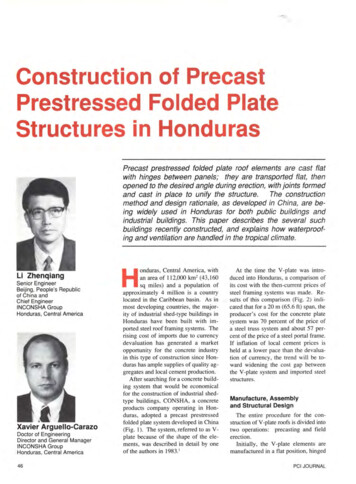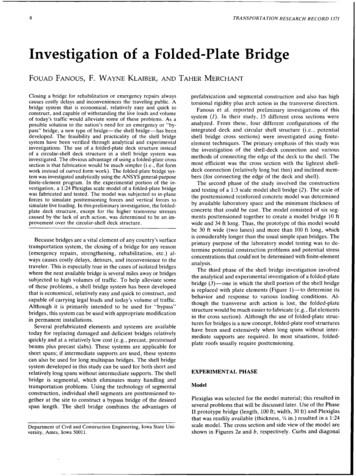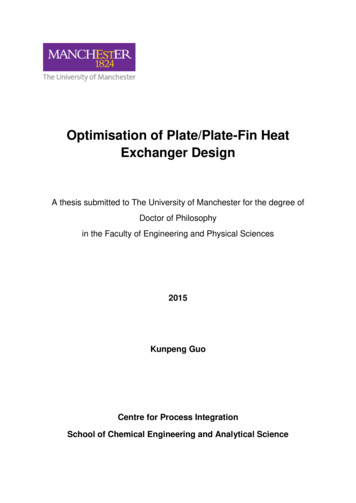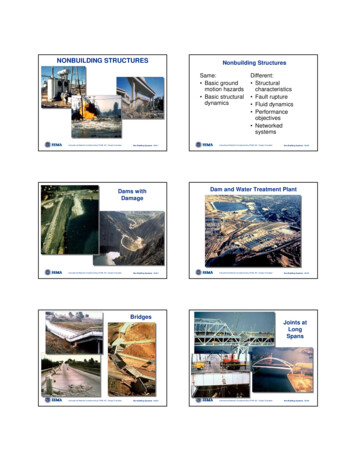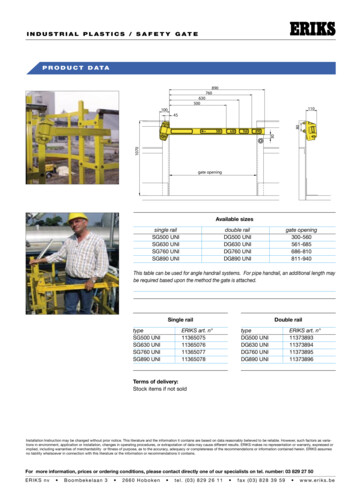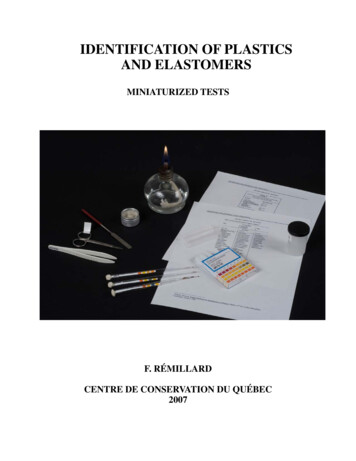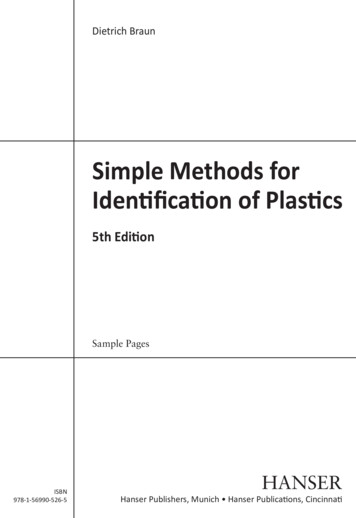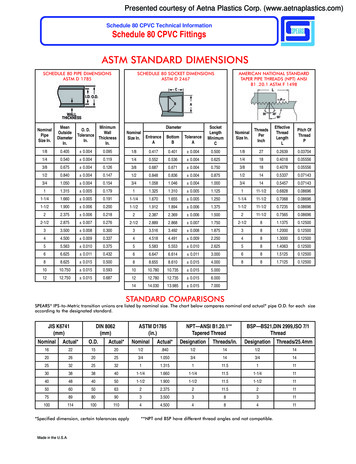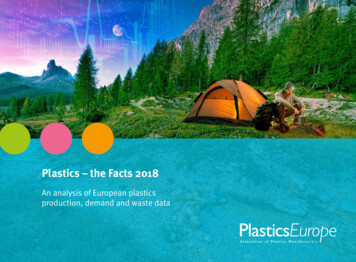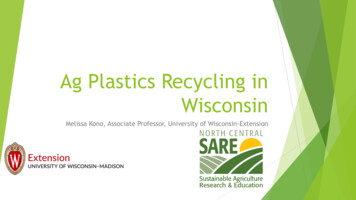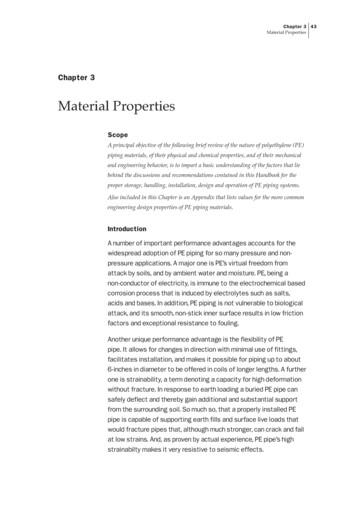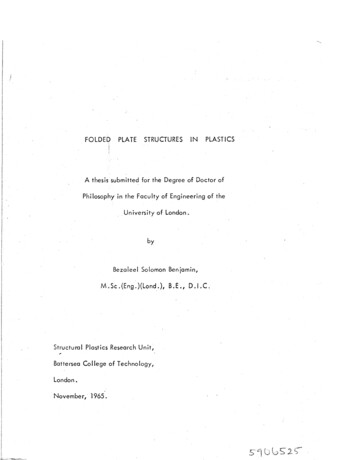
Transcription
FO LDEDPLATESTRUCTURESINPLASTICSA thesis subm itted for the D egree o f D octor o fPhilosophy in the F a c u lty o f E ngineering o f theU n iv e rs ity o f London.byB eza le el Solomon B enjam in,M .S c .( E n g .)(L o n d .), B .E ., D . I . CS tructural Plastics Research U n it,Battersea C o lle g e o f T e ch n o lo g y,London.N o v e m b e r, 1 9 6 5 .
ProQuest Number: 10800474All rights reservedINFORMATION TO ALL USERSThe quality of this reproduction is d e p e n d e n t upon the quality of the copy subm itted.In the unlikely e v e n t that the a u thor did not send a c o m p le te m anuscriptand there are missing pages, these will be noted. Also, if m aterial had to be rem oved,a n o te will ind ica te the deletion.uestProQuest 10800474Published by ProQuest LLC(2018). C opyright of the Dissertation is held by the Author.All rights reserved.This work is protected against unauthorized copying under Title 17, United States C o d eM icroform Edition ProQuest LLC.ProQuest LLC.789 East Eisenhower ParkwayP.O. Box 1346Ann Arbor, Ml 4 8 1 0 6 - 1346
A B S T R A C TThis thesis is an in vestig atio n into the use o f plastics instructures o f the fo ld ed p la te ty p e .Plastics as a structural m a terial has first been c r it ic a llye v a lu a te d w ith p a rtic u la r reference to the types that may be used fo rstructural purposes.The d ifferen ces in the m ech an ical propertiesb etw een these m aterials and c o n ven tio n al m aterials have beenexam ined in d e t a il.C o n ven tio n al design concepts have beensu ita b ly e n la rg e d to take these differen ces into a c c o u n t.Folded p la te structures in plastics b u ilt up from p re fa b ric a te dunits have then been e x a m in e d .The tw o -p la te u n it enables the com pletep re fa b ric a tio n o f a v a rie ty o f structures, p a rtic u la rly o f the compositety p e , and has been selected fo r fu rth er study.The existin g approachto the analysis o f fo ld ed plates has been m od ified for a p p lic a tio n to suchstructures in p la s tic s.This m o dified approach is p a rtic u la rly su itable fo ruse w ith composite fo ld ed p la te structures formed from n o n -p rism atic p la te s .Large transverse d e fle c tio n s o f the structure can be c o n v e n ie n tly taken intoa c c o u n t.This m o d ified approach has been v e rifie d by ex p e rim e n ta l w orkon the roof stru ctu re, the tw o -p in n e d composite fo ld ed p la te portal fram eand a composite fo ld ed p la te b arrel v a u lt .
Folded p la te structures in plastics can be o f single skino r sandwich co n stru ctio n .The properties o f expanded polystyrene andrig id polyu reth an e foam for use as low density cores in such sandwichconstruction have been d e te rm in e d .A prototype composite folded p la te barrel v a u lt ofsandwich construction has been d evelo p ed and tested .S p eciala tte n tio n has been p aid to the connections betw een the fu lly p re fa b ric a te du n its.The costs o f the structure have been b rie fly e x a m in e d .The testresults have been analysed and the th e o re tic a l and e x p erim en talbeh avio ur o f the structure have been com pared.F in a l conclusions have been drawn and suggestions fo r fu rth erresearch have been m a d e .
I should lik e to ackn o w led g e my g ra titu d e toProfessor Z . S. M a k o w s k i, Head o f the D epartm ent o f C iv ilE n g in eerin g , Battersea C o lle g e o f T ech n o lo g y, for his kin dhelp and g u id a n c e .His perspective v ie w o f the problem hasbeen in v a lu a b le .I should also lik e to a ckn o w led g e my g ra titu d e tothe Shell C h em ical C o . L t d ., for the Shell C h em ical C o .research scholarship, for the free supply o f m aterials and forgenerous grants towards the cost o f the p ro to ty p e .A specialword o f thanks is due to M r . R. F . Salmons and D r . E . N a rra c o tto f the Shell C h em ical C o . for th e ir sustained interest in this w o rk .
WORK ACCEPTED FOR PUBLICATIONThe e n tire contents o f this thesis are the work o f the au th o r,done a fte r being registered for the degree o f D octor o f Philosophy, inthe F a c u lty o f E ngineering o f the U n iv e rs ity o f London.Some o f thew ork has since been acc ep te d for p u b lic a tio n as follow s:1.The contents o f C h ap ter 1 have been w ritte n in the formo f a paper e n title d 'An E valu atio n o f Plastics as a S tructural M a t e r i a l '.This has been ac ce p te d for p u b lic a tio n by "The Consulting E n g in e e r" ,London.2.The contents o f Chapters 2 , 3 , 5 , 6 and part o f 7 , in acondensed form w ere read as a paper in c o lla b o ra tio n w ith ProfessorM akow ski a t the co nference 'Plastics in B uilding Structures' held inLondon in June 1 9 6 5 .The paper was e n title d 'The A nalysis of FoldedPlate Structures in P la s tic s .'The proceedings are to be published byPergamon Press la te r this y e a r.3.The contents o f A p p en d ix 1 have been w ritte n in theform o f a paper e n title d 'Expanded Polystyrene and Rigid PolyurethaneFoam Cores in S tructural Sandwich C o n s tru c tio n '.This has been a ccep tedfor p u b lic a tio n by " C iv il Engineering and Public Works R e v ie w " , London.
C O N T E N T SCHAPTERPAG E1.Plastics as a structural m a te r ia l.72.Folded p la te structures in p la s tic s .193.The fo ld ed p la te roof (in te rn a l u n it ).324.The fold ed p la te roof (e x te rn a l u n it).545.The tw o -p in n e d , fo ld ed p la te portalfra m e . 6.The folded p la te barrel v a u lt.7.Tests on a prototype fo lded p la teb arrel v a u l t .79931268.Conclusions.1749.Suggestions for fu rth er res e a rc h .178A P P E N D IX 1.183A P P E N D IX 2 .207REFERENCES.279
7CHAPTER1Plastics as a structural m a te r ia l.1.1In tro d u ctio n :The use o f plastics as a structural m a terial w ill c re a te controversy formany years to co m e.Plastics when used stru c tu ra lly have some advantages -and some disadvantages - as,com pared to co n ven tio n al m aterials such as s te e l,alum inium o r concrete .T h e ir disadvantages, ap a rt from high cost, lie m a in lyin the properties o f the m a te ria l w h ich w ill be considered in g re a te r d e ta il in1 .3 .It w ould th erefo re be a p p ro p riate to discuss b r ie fly firs t, the advantageso f those plastics suitable for structural a p p lic a tio n s .1 .1 .11.A dvantages o f plastics o v e r c o n v e n tio n a l m aterials:Structural plastics have h igher s tre n g th /w e ig h t ratios thanmost o th er en g in ee rin g m a te ria ls .2.They are a ttra c tiv e in appearance and can contributesu bstantially to the a rc h ite c tu ra l b eauty o f the stru ctu re.be made tra n s lu c e n t.They can e a s ilyThey can also be e a s ily pigm ented to g ive desiredcolours to the stru ctu re.3.M a n y plastics have e x c e e d in g ly good corrosion resistance,w hich is fa r superior to th at of many con ven tio n al e n g in eerin g m a te ria ls .4.Plastics are ve ry am enable to p re fa b ric a tio n .This p ro p erty,together w ith th e ir lig h t w e ig h t, makes them ve ry useful m aterials in systemso f industrialised b u ild in g .
In order to be a b le to design in p lastics, it is first necessary tounderstand v e ry thoroughly the m aterial its e lf.To do so is not easy,co m p licated by the fa c t that there are m any, many types o f plasticsused for a v a rie ty o f purposes.H o w ever for structural purposes thereare o n ly a small number o f e ffic ie n t plastics and these w ill now beconsidered in g re a te r d e t a il.1 .2Plastics su itab le for structural ap p lic a tio n s :Plastics can be classified b a s ic a lly into two main groups;therm oplastic m aterials and therm osetting m a te ria ls .Therm oplastic m a te ria ls soften on the a p p lic a tio n of h e a t.They hence e x h ib it considerable creep under load p a rtic u la rly ate le v a te d tem peratures.P o ly v in y lc h lo rid e (p vc) and p o ly m e th y lm e th a c ry la te(Perspex) are exam ples o f therm oplastics that can be used for lig h t structurala p p lic a tio n s .G e n e r a lly th ey are in sheet form and are used re in fo rc e d .They have the advan tag e o f being e a s ily am enable to shaping or m ouldinginto d iffic u lt shapes.They are isotropic and being unreinforced show veryconsistent p ro p erties.Perspex domeshells b u ilt in F in lan d may be g iven asan exam ple of the structural use to w hich these m aterials may be p u t.have a di a m eter o f 19 f t . 4 i n . and a h eig h t o f 6 f t .TheyThey w ere designed fo r asnow load o f 3 0 .7 lb s /s q .ft. and a w ind load o f 2 0 .5 lb s /s q .ft. Therm osetting m aterials once cured, do not soften on the a p p lic a tio no f h e a t.W hen rein fo rced th e y e x h ib it higher strengths and a fa r less
tendency to creep than the therm oplastics.The p o ly e s te r, e p o x id e , andp h e n o lic resins are exam ples o f therm osetting p la s tic s .polyesters are by fa r the most w id e ly used.O f these, theThey are r e la tiv e ly cheap andg ive good properties in rein fo rced la m in a te s .The ep oxid e resins g iveextrem e ly good p ro p erties, but th ey are more expensive than the p o lyesters.The p h en o lic resins g ive good properties w hich are m ain tain ed even a t hightem peratures.They are hence p a rtic u la rly su itable for such w o rk .H o w everp h en o lic resins require hot cures and high la m in a tin g pressures and thislim its th e ir a p p lic a tio n s m ain ly to the aerospace industry.A ll these therm osetting resins cannot be used s tru c tu ra lly by themselvesand have to be rein fo rced w ith su itable reinforcem ent such as glass, c lo th ,paper or asbestos.For high tem perature w o rk , asbestos rein fo rced p h e n o liclam inates are the most s u ita b le .The commonest reinforcem ent is glass.glass reinforcem ent is a v a ila b le m a in ly in three forms:a.Chopped strand mat:The2This is the most im portant type o f glassfibre rein fo rcem en t and consists o f about 2 " long fibres random ly o rie n te d .The resulting lam in ate is hence es s e n tia lly iso tro p ic.b.Rovings:These consist o f a d e fin ite number o f continuous,p a r a lle l, bundled but untw isted strands o f glass.They im part v e ry highd ire c tio n a l strengths and for this reason fin d great a p p lic a tio n as re in fo rc e ments in fila m e n t wound structures such as pipes, tanks, rocket casings e t c .
c.Cloths:strong lam in ates.These are w oven fabrics w h ich g ive e x tre m e lyThey are h ow ever e x p e n s iv e .C lo th rein fo rced lam inatesare anisotropic in th e ir p ro p erties.In single skin construction, the rein fo rced lam inates can be usedby them selves.H ow ever for large spans it is necessary to use structuralsandwich construction in w hich the thin rein fo rced lam inates are bonded toa low density c o re .a x ia lThe facings then take the bending momentforces and the core is assumed to take a ll the shear.and theThe coresthemselves can be o f low density p lastics, and the four m ain types areas follow s:a.R igid p o lyu reth an e foamb.Expanded polystyrenec.Expanded pvcd.Phenolic fo a m .O f these, the rig id po lyu reth an e foam and the p h e n o lic foam aretherm osetting p lastics, the o th er two being therm oplastics.The rig idp olyurethane foam has an ad van tag e o ver the o th er three in that it can befoamed d ire c tly onto the lam inates w hich makes it p a rtic u la rly su itable forinsitu w o rk .Further the p o lyester lam inates can be d ir e c tly 'l a i d 1 on i t .This cannot be done w ith expanded polystyrene as the polystyrene isc h e m ic a lly a tta c k e d .Expanded pvc and p h en o lic foam are not a tta c k e d .H ow ever the surface o f p h en o lic foam has to be sealed in o rder to p reven tthe p en etratio n o f la m in atin g resin into the fo am .
The au th o r has ca rrie d out a d e ta ile d in vestig atio n into theo f expanded polystyrene and rig id p o lyurethane foam w ith a v ie wm aterials as cores in structural sandwich co n stru ctio n .propertiesto using theThe results o f thisin vestig atio n are g iven in A p p en d ix 1.1 .3The m ech an ical b eh av io u r o f plastics:As has been seen, the types o f plastics su itable for structuralap p licatio n s are fa ir ly lim ite d .To be a b le to use these plastics e f fic ie n tlyhow ever, it is ve ry necessary to study th e ir m echan ical b eh avio u r and toh ig h lig h t the d ifferen ces in such b eh avio u r betw een these m aterials and thecommonly used en g in e erin g m a te ria ls .The main d ifferen ces may be listedas under:1.up to y ie ld .2.The stress/strain curves o f plastics are not u su ally lin e a rIn some cases there may be no y ie ld a t a l l .The modulus o la s t ic it y in tension o f plastics is notnecessarily the same as th a t in compression.3.The modulus o f e la s tic ity o f plastics is v e ry lo w .4.Plastics can e x h ib it anisotropic b e h a v io u r.5.The m ech an ical b eh av io u r o f plastics is a ffe c te d bythe rate o f strain in g o f the m a t e r ia l.6.The m ech an ical b eh av io u r o f plastics is a ffe c te d bythe tem p era tu re.7.Plastics creep co n sid erably under load w ith tim e .
128.Plastics show a red u ction in u ltim a te strengths w ith tim eeven under static lo a d in g .9.The properties o f plastics can be a ffe c te d by enviro n m en talco n d itio n s.1 0. The fire resistance o f plastics is v e ry po o r.Each fa c to r w ill now be considered in g re a te r d e t a il.1 .3 .1The stress/strain curves o f plastics are not u su ally lin e a r upto y ie ld .In some cases there may be no y ie ld a t a l l .The im portance o f this fa c to r depends la rg e ly on the typ e o fplastics used.For glass fib re rein fo rced plastics, the n o n -lin e a r ity up tostrains o f about 0 .3 % is small and the tan
to the analysis of folded plates has been modified for application to such structures in plastics. This modified approach is particularly suitable for use with composite folded plate structures formed from non-prismatic plates. Large transverse deflections of the structure can be conveniently taken into account. This modified approach has been verified by experimental work
